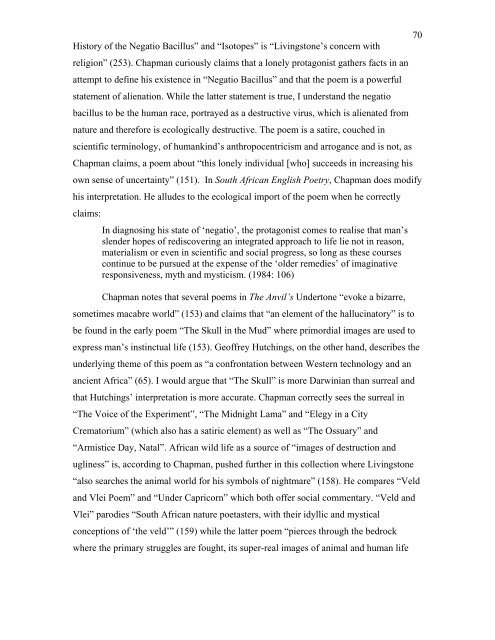"Symbiosis or Death": - Rhodes University
"Symbiosis or Death": - Rhodes University
"Symbiosis or Death": - Rhodes University
You also want an ePaper? Increase the reach of your titles
YUMPU automatically turns print PDFs into web optimized ePapers that Google loves.
70<br />
Hist<strong>or</strong>y of the Negatio Bacillus” and “Isotopes” is “Livingstone’s concern with<br />
religion” (253). Chapman curiously claims that a lonely protagonist gathers facts in an<br />
attempt to define his existence in “Negatio Bacillus” and that the poem is a powerful<br />
statement of alienation. While the latter statement is true, I understand the negatio<br />
bacillus to be the human race, p<strong>or</strong>trayed as a destructive virus, which is alienated from<br />
nature and theref<strong>or</strong>e is ecologically destructive. The poem is a satire, couched in<br />
scientific terminology, of humankind’s anthropocentricism and arrogance and is not, as<br />
Chapman claims, a poem about “this lonely individual [who] succeeds in increasing his<br />
own sense of uncertainty” (151). In South African English Poetry, Chapman does modify<br />
his interpretation. He alludes to the ecological imp<strong>or</strong>t of the poem when he c<strong>or</strong>rectly<br />
claims:<br />
In diagnosing his state of ‘negatio’, the protagonist comes to realise that man’s<br />
slender hopes of rediscovering an integrated approach to life lie not in reason,<br />
materialism <strong>or</strong> even in scientific and social progress, so long as these courses<br />
continue to be pursued at the expense of the ‘older remedies’ of imaginative<br />
responsiveness, myth and mysticism. (1984: 106)<br />
Chapman notes that several poems in The Anvil’s Undertone “evoke a bizarre,<br />
sometimes macabre w<strong>or</strong>ld” (153) and claims that “an element of the hallucinat<strong>or</strong>y” is to<br />
be found in the early poem “The Skull in the Mud” where prim<strong>or</strong>dial images are used to<br />
express man’s instinctual life (153). Geoffrey Hutchings, on the other hand, describes the<br />
underlying theme of this poem as “a confrontation between Western technology and an<br />
ancient Africa” (65). I would argue that “The Skull” is m<strong>or</strong>e Darwinian than surreal and<br />
that Hutchings’ interpretation is m<strong>or</strong>e accurate. Chapman c<strong>or</strong>rectly sees the surreal in<br />
“The Voice of the Experiment”, “The Midnight Lama” and “Elegy in a City<br />
Cremat<strong>or</strong>ium” (which also has a satiric element) as well as “The Ossuary” and<br />
“Armistice Day, Natal”. African wild life as a source of “images of destruction and<br />
ugliness” is, acc<strong>or</strong>ding to Chapman, pushed further in this collection where Livingstone<br />
“also searches the animal w<strong>or</strong>ld f<strong>or</strong> his symbols of nightmare” (158). He compares “Veld<br />
and Vlei Poem” and “Under Capric<strong>or</strong>n” which both offer social commentary. “Veld and<br />
Vlei” parodies “South African nature poetasters, with their idyllic and mystical<br />
conceptions of ‘the veld’” (159) while the latter poem “pierces through the bedrock<br />
where the primary struggles are fought, its super-real images of animal and human life

















